The Akhal-Teke Colors
By Todd Keith and Jessica Eile-Keith
The color range in the Akhal-Tekes is one of the hallmarks of the breed.
The variety of colors goes from the blue eyed creams over golden buckskins, golden bays to the jet black. Many individuals show a metallic sheen to their coats seen in no other breed.
The wide range of colors, many of them golden has been mentioned by historians such as Strabo (63BC - 21AD), who visited all countries in the Near East meant that the Parthians have the best horses in the. The Parthian horse was known for its beauty, speed and stamina. The ancient repeats as saying "Nisa omnes eqous flavos habet" Nissa (the capital of the Parthian empire, today located some kilometers from the capital of Turkmenistan) has only golden colored horses.
Alexander the Great (356-323 BC) during his campaign in Central Asia encountered the golden horses as well, in the chronicles about his expeditions one can read "in the Eastern part of Alexandria (todays' Turkmenistan)"....there are horses of a perfect breed, they are fierce, fast and enduring, their colors are white, the colors of the rainbow and the colors of the sunrise".
The golden colors and the rainbow variations of colors is caused by a dilution of the basic colors bay and chestnut, this dilution gene is a mutation that might as well have occurred for the first time in the ancient ancestors of Akhal-Teke breed.
Horse color terminology
The internationalization of the horse breeds is causing some challenges to the registration procedures. There are no overall international standards for the correct terms for all horse colors. Writing this document in English we have chosen to use the most common names for the colors we describe. We would say that the terms for the colors are a mix of British English and American English. The terms for the basic colors such as bay and black are more or less standardized while terms such as rabicano and sabino are relatively new terms coined in the USA based on the Spanish language. | 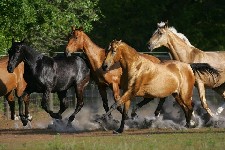
Photo: Bob Langrish
Black, bay, buckskin, palomino

Palomino & black

Bay & cream
|
Domesticated basic colors
The basic coat colors for domesticated horses are bay (genotype A-E-), seal brown, (genotype not yet specified), black (genotype aa E-) and chestnut (genotype A- ee) .
The Akhal-Teke stallion line founders Dor Bairam, El, Gelishikli and Skak were bay, Kaplan was black, Fakirpelvan was chestnut | 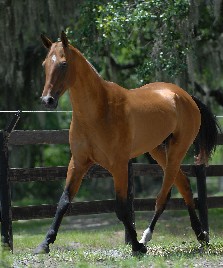
Bay |
Horse color modifiers
The Cream gene
The cream gene (Ccr) dilutes bay to buckskin and chestnut to palomino.
The cream gene in heterozygot dilute the red pigment (feomeanlin to yellow but has no or very little effect on the black pigment (eumelanin).
Black horses that have the cream gene are not much affected and it is not possible to see if a black horse has the cream gene.
Therefore it is possible for two horses that are registered as black to produce a cream colored offspring.
When the cream gene is in homozygous it dilutes also the black pigment, both the black and red are diluted to a light cream color. The skin is pink and the eyes are blue. This color is called cream or cremello.
Basic color with heterozygot cream gene genotype
Bay buckskin A-E-Ccr
Brown smokey or sooty buckskin (Am) a-E-Ccr or aaE-Ccr
Black smoky black (Am) aa E- Ccr
Chestnut palomino --ee Ccr
The cream gene also dilutes dun red colors to a lighter shade.
The Ccr gene dilutes only the brown color so a bay horses with one loci of Ccr will get a yellow coat color but the black points such as legs, mane, tail and eel will remain black, this color is called buckskin and comes in a wide range of shades from very dark to almost white body color. The chestnut horse will get a flaxen or white mane with a yellow body, this color is called palomino and comes in a variation of shades. .
The black horses can carry the recessive Ccr- gene are not diluted.
The most important founders of the Akhal-Teke breed, Boinou (b 1885) was buckskin.
Modern line founders such as Peren, Melekush, Sere, Toporbai, Karlavach and Everdy Teleke were also buckskins. | ,
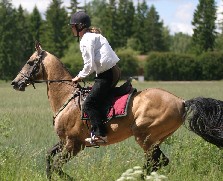
Buckskin
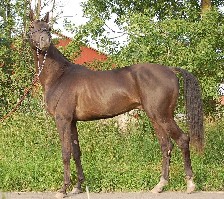
Dark buckskin

Cream
|
The Dun gene
The gene for the wildhorse color or dun color is a simple, dominant trait called Dn after the English word dun that means “of dull grayish-brown color as of ass or mouse” (The Concise Oxford Dictionary 7th edition).
Ancient English dunn means nut brown.
The Dn gene was earlier called D as for dilution, dilution is a recessive trait, dd, that exists in among others cats and dogs. However the dd trait does not resemble the Dn trait as it is recessive compared to the Dn trait that is dominant, hence the change of the name of the gene. .
The dun trait makes the coat colors dull compared to the domesticated basic colors. The wild horse colors are yellow dun or dun (genotype A-E-Dn-), mouse dun (Am. English grullo) ( aa E- Dn-), red dun (A-ee Dn-).
Note that unlike the cream gene, the dun gene dilutes the black pigments as well.
The dun colors does not exist in the English Thoroughbred, the Arabian horse, the Akhal-Teke horses , the Standardbred or the European Warmbloods.
The dun trait does exist in the American Quarterhorse.
Note that there are no pure bred Akhal-Tekes registered as dun (Russian term savrasaya) in any of the Russian General Studbooks.
The yellow horses with black points are without exceptions registered as bulanaya the Russian term for buckskin.
However, in translation to English, sometimes the term bulanaya is translated into the British English generic term for diluted colors – dun, this sometimes causes the misunderstanding that there are dun colored Akhal-Tekes. . |  |
The Grey gene
The grey horse is born with full pigmentation, after the first shedding some hairs in the coat turn white and with each shedding more white hairs appearing until the coat turns white.
The grey gene (genotype G) is dominant. If one of the parents is homozygous (GG) all offspring will turn grey
Basic color Genotype Grey color
bay A-E-G- grey (born bay)
black aa E-G- grey (born black)
chestnut --ee G- grey (born chestnut)
seal brown grey (born seal brown)
Some studbooks register the grey foals with the basic color they are born with. The Russian General Studbook does not register the basic color of the grey horses.
The grey gene also affects the cream colors so a grey horse can be born buckskin, palomino, sooty black or cremello.
This means that a grey horse born buckskin that is not homozygous for grey (GG) can produce buckskins, palominos and cremellos.
A homogygous cream (CcrCcr) will hide the grey color and turn cream colored with pink skin and blue eyes. One example of this is the stallion Gayaz by a buckskin sire and a grey (born buckskin dam).
The grey color modifier exists in the Akhal-Teke breed. The line founders Arab, Kir Sakar, Posman, Aksakal and Akbelek were grey. | 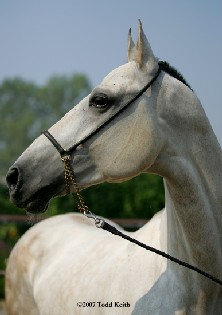 |
The roan
The roan (genotype Rn) is born grey or becomes grey after shedding the foal coat.
The Rn gene affects all colors. The difference between the roan and the grey is that the head of the roan is always darker than the body but the head of the grey is always lighter than the body.
The genetic combination RnRn is lethal which means that all roans that are born have the genotype Rnrn.
There are no roan colored Akhal-Tekes registered. There have been no observation of this modifier in the Akhal-Teke breed.
The rabicano
Some horses have a few white hairs mixed in with their coat colors, sometimes the white hairs are concentrated around the tail of flank of the horse. These mixed in white hairs can be called white ticking or rabicano from the Spanish rabo “tail” and cano “grey”).
Some studbooks describe this as for example bay rabicano or black rabicano. The rabicano modifier is not noted in the Russian General Studbook, however, this modifier has been observed in the breed and is not unusual.
English term - Russian Government Studbook term
Bay - gnedaya
Black - voronaya
Chestnut - rijaya
Buckskin - bulanaya
Palomino - solovaya
Cream - zabellovaya
Grey - seraya | 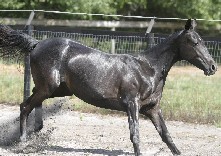
Rabicano
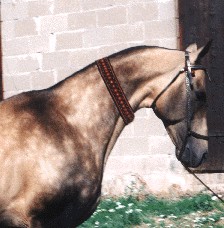 Buckskin with wings Buckskin with wings |
The Sabino markings
The sabino (genotype Sb) markings is a dominant gene. It often has four or two white legs and sometimes big white markings on the face as well as white spots on the abdomen.
The Sabino markings are not noted in the Russian General Studbook but sabinos have been observed in the breed. | 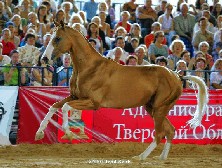
Sabino |
The metallic sheen
Many Akhal-Tekes display a metallic sheen to their coat that is unique for this breed.
Little is known about how it is inherited or which genes that causes the sheen.
According to our observations it seems like the metallic sheen can occur in offspring from non-metallic parents as well as metallic parents have given metallic offspring.
The metallic sheen in the palomino color manifest itself in the newborn foal that has blue eyes and light skin that during the first week turns darker.
The metallic sheen might act differently together with the cream gene (Ccr) but this is still an interesting subject for research.
The metallic sheen is not noted in the Russian General Studbook. | 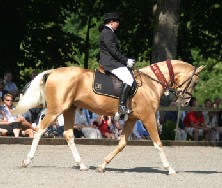
Metallic palomino |
English term Term in the Russian Government Studbook
Bay gnedaya
Black voronaya
Chestnut rijaya
Buckskin bulanaya
Palomino solovaya
Cream izabellovaya
Grey seraya | 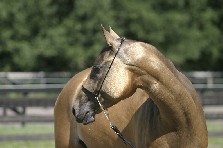
Metallic buckskin |
Authors’ comments
A modernization of the registration procedures from paper registration to digital registration of pure bred Akhal-Tekes together with a more accurate description of basic color with modifier as well as known genotype in the cases where horses have been genetically tested, such as the red factor test for cream colored horses, this together with color photos of each registered horses with a DNA-test that would be open to international scientists would open new possibilities for genetical research for this breed.
As for today the color and their modifications are not described according to international standards, the obsolete blood typing results are, even if they could be used for research, not available outside Russia.
This means that scientists interested in the unique color schemes of the Akhal-Teke will have to find data that is available in western institutions spread over the world that has been doing the DNA-typing for individual owners that have allowed the DNA for their horses to be used for future research.
We do hope that the recently initiated online registration project will open up new possibilities for scientists as well as individuals to learn more about the colors and traits of the Akhal-Tekes.
Literature
Furugren B: Hästen Färger. Natur och Kultur. 2000.
Vol III* – Vol X Government Studbook for Akhal-Teke Breed. 1941 – 2005.
* The volume III of the first studbooks published during the Soviet Union Era is the first studbook published for the Akhal-Teke breed. The volume I and II were for other breeds such as Thoroughbred and Kabardiner horses.
| 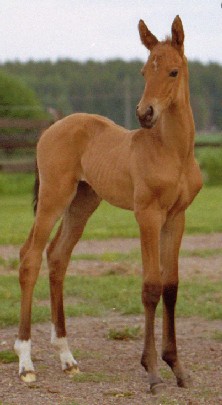
Bay |
|